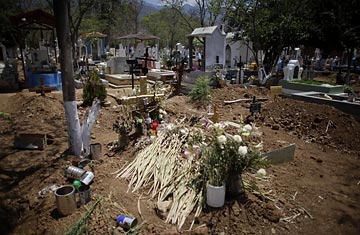
Adela Maria Gutierrez, Mexico's first confirmed swine flu victim, is buried here in Oaxaca
Her name was Adela Maria Gutierrez and she was 39 when she died, the first known fatality from the virus that swept through Mexico and into the rest of the world. A month before she took ill, she had just found temporary work, a government pollster job that sent her from door to door in the outskirts of Oaxaca, the city where she lived with her husband, a welder, and their three daughters, ages 21, 17 and 10. Her mother-in-law, whose house she lived in, says Adela worked very hard "from 8 in the morning until 11 at night every day, even the last days, when she was not feeling so well."
On April 2, Adela, who had diabetes, said she felt tired, cold, feverish. She suffered from diarrhea."We thought it was a normal cold," says her husband Jose Luis (who does not want his last name used). "We do not have Social Security or Seguro Popular [public insurance], so we went to a private doctor [on April 5]. She treated [Adela], and we paid her and bought the medicines." The physician said Adela had a throat infection and prescribed amoxicillin and Amboxal. But Adela did not get better. On April 7, she went back to the doctor by herself. She had coughed up blood that day and had a 40-degrees Celsius fever (104 degrees Fahrenheit). Her husband says the doctor recommended another medicine. "It did not work," Jose Luis says. Adela's cough became worse, she was suffering from respiratory distress and her hands and feet were showing signs of cyanosis — that is, they were turning blue. On April 8, they returned to the doctor a third time. It was then, Jose Luis says, "the doctor told us to take her to the Civil Hospital." On the 9th at 12:45 p.m., Adela was admitted to the hospital by way of the emergency room. She was diagnosed with pneumonia. (See five things you need to know about swine flu.)
Adela had already been ill for eight days, but the next five days saw a further and rapid decline in her health. On the second day of hospitalization, she began to suffer from hypoxic encephalopathy — her brain was not receiving enough oxygen — and she was put on a ventilator. The next day, X-rays showed that both sides of her lungs were damaged. She continued to go downhill until the afternoon of April 13, when she died after suffering cardiac arrest. (See pictures of Mexico in the time of swine flu.)
Her husband and daughters stayed as close as they could throughout the process. "I was happy," says Jose Luis, "that even though the hospital has a rule of not allowing minors in, they let my middle daughter see her and say goodbye." The 17-year-old says, "I was sad to see so many tubes, but the social worker was very nice to us and allowed me to kiss her and stay with her."
Then the hospital had a request. "After she died," Jose Luis says, "they told me they needed some samples to be sent to Mexico because her disease had been so different, so I let them." The results of the biopsies of Adela's lungs and liver would help send Mexico and the world into a panic: she had the H1N1 swine flu virus and was the first known fatality. On the day she died, the state of Oaxaca notified the Ministry of Health that it had a case of atypical swine flu; and on Sunday, Health Minister Dr. Martin Vazquez recognized Oaxaca as being the state that started the alert. (Though other affected states may have suffered earlier infections, they did not notify the central government.) And so Adela's death kick-started the epidemiological investigation. So far, 159 people in Mexico are suspected to have died from the H1N1 virus. The hospital in Oaxaca currently has three patients suspected to be suffering from the virus who are not responding well to treatment.
"Since she died," Jose Luis says, "doctors have come and asked us many questions regarding her work and anything we can remember — the names of her friends, colleagues, any place different from the usual that she had gone — but we really do not know." The physicians have also been monitoring the family's health. "We have not had any symptoms, thank God," Jose Luis says. "So we do not need to be tested. If we get sick, we will let them know, but now, there is no problem at all." Still, he says, "they keep on coming every day."
In a middle-class suburb with streets filled with single homes, one and two stories high, with garages and mom-and-pop shops, with interior patios and small gardens lined with flower pots, is the street where Adela lived with her husband and daughters. There, Jose Luis continues to mourn his wife. He wants her passing to have meaning. "What I want is [a piece of official] paper that says that she had this flu. I just want to see it in writing. I want my daughters to know that even in death she helped others. They say she was the first case. [The Health Minister] says that because of her ... of her case, the whole thing was discovered. They say she was a heroine. That is what I want my daughters to know."
See the world's most influential people in the 2009 TIME 100.
